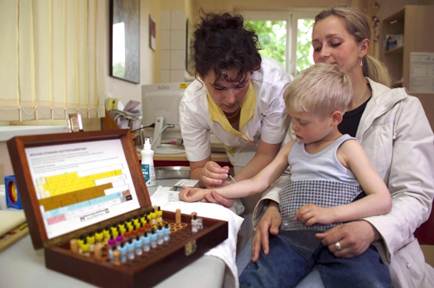When Andrea’s son – Ben – was 6 years old,
he started to break out into the rash, and his eyes had a red rim.
These symptoms appeared when he played
outside. Andrea immediately made him drink an allergy medicine and they rapidly
disappeared. But the problem recurred 1 week later which made her worry a lot
and she brought him to the doctor. Ben had pediatric allergist, and the test
result revealed that he was allergic to the pollens of flowers and grasses. “There
are a lot of trees around our house. It is possible that the boy plays and
rolls on grass. And the allergy happens.” – said Andrea.

Allergy
to the pollens of flowers and grasses
Allergies caused by food, medicine or
environment are parents’ concern, making then want to have an allergy test for
their kids. Typically, they can’t tell the difference between an anaphylactic
shock and ordinary sore eyes. However, the allergy test is not really necessary
in all cases and parents should know its limits. Some advices parents should
take into consideration to decide to take the allergy test for their kids or
not are as follows.
Can allergy be tested?

Can
allergy be tested?
According to Janet Roberts, a pediatric
allergy expert, “No age is too young to do an allergy test; you should do it as
soon as there are germs of allergy”. However, the problem that parents
encounter is they can’t recognize the allergy germ in kids’ bodies before the
disease really emits. For example, we can’t know if kids are allergic to pollen
or not until they catch the disease in spring.
After researching, doctors made a physical
test of whether kids would have the rash when taking medicine and they would
have eye sore caused by animal’s feather. Your task was providing fully with
symptoms when you started to catch the disease. Children having chronic asthma,
otitis or surinfection eczema stand a high chance of being allergic. Meanwhile,
if a child lives in a family which has a tradition of being allergic, he or she
may not get that allergy like his/her parents and siblings. For example, only 1
– 2% children have nut allergy, this possibility rises only to 5% if their
siblings used to eat nuts. Moreover, if a child has siblings who catch this
allergy, that family won’t restore the food that causes allergy. Therefore,
that child will stand little chance of catching the disease.
However, there has been no research giving
a definite solution about allergy possibility at children. According to Dr.
Robert, “Nothing is 100% sure. We used to have wrong test results and diagnosis
for pediatric allergy and it is impossible to make a conclusion without linking
to individual situations”.
Test formats
Pricking skin with needles is a quick,
cheap way and it can test many kinds of allergies concurrently. The doctor uses
a liquid mixture containing allergens and applies on kids’ skin, usually on
their arms. Concurrently, he pricks that skin area with a needle. If there is a
swell, it proves that you are allergic to that liquid.
A more sensitive method is testing inner
skin, which enables to test one kind of allergy such as penicillin or bee sting
– substances that you can’t be aware of if using the pricking method. The
testing inner skin includes diagnosing reactions of body to allergens among
layers of epidermis However, in some cases, both methods give wrong results.
Stuart Carr – an expert in allergy and immunity, said: “The skin thickness may
cause a “negative” result, making you misunderstand about your situation”.
If the pricking method and inner skin are
not effective, or give unidentified results because your children are taking
medicine or have surinfection eczema, testing blood is an ideal method. Blood
is tested based on separated antibodies. However, these tests are expensive and
limited in some specialty hospitals. They take a lot of time to diagnose and
may give wrong results also. In addition, it is not easy to take children’s
blood.
The most exact method is “open experiment”.
Your children will try to absorb in one kind of food or an allergen. For example:
Let them eat some nuts to observe bodies’ reaction – this is the simplest
exercise to check if the allergy recurs or not. Keep in mind that tests can
give different results after some years, depending on how many are antibodies
left in your body. Therefore, in fact, you should test your children regularly.
This may worry parents, but with the technology of hospitals, this process can
be executed safely and effectively.
What should be done after testing?
After tests, children need some next steps
of treatment to prevent new allergies (for examples: teenagers stand a high
chance of being allergic to environment), or control the recurring allergies.
No one can be confident that they completely get rid of allergies: some kids
are allergic to milk and egg and this allergy recur usually. Meanwhile, only 1
out of 5 children having nut allergy can get rid of it completely. Follow-up
examination depends on kids’ ages and allergy kinds, but usually from 1 to 3
years. In addition, Dr. Roberts noted: “Children grow up so fast, and the
immune systems develop as well so they can catch allergy at any time. Regular
allergy test is the method of collecting information of children’s bodies so
that normal allergies can be prevented and limited”.